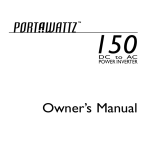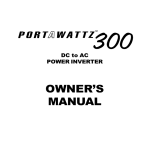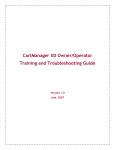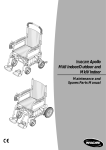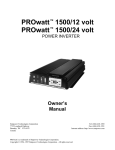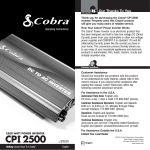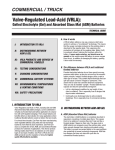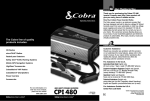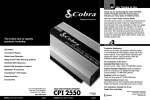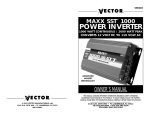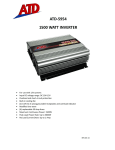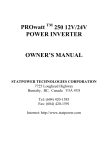Download Manual - Effective Solar
Transcript
DC to AC
POWER INVERTER
OWNER’S MANUAL
Table of Contents
1. Introduction .................................................................................................... 2
2. How Your Portawattz 600 Works................................................................. 2
2.1 Principle of Operation............................................................................ 2
2.2 Portawattz 600 Output Waveform ......................................................... 3
3. Installation ...................................................................................................... 4
3.1 Where to Install...................................................................................... 4
3.2 Battery ................................................................................................... 5
Battery Type..................................................................................... 5
Battery Sizing ................................................................................... 6
Using Multiple Batteries................................................................... 8
Battery Tips...................................................................................... 8
Alternators and Charging Systems.................................................... 9
3.3 Cables .................................................................................................. 10
Ground Wiring ............................................................................... 10
DC Wiring ...................................................................................... 10
4. Operation ...................................................................................................... 11
4.1 Controls and Indicators........................................................................ 11
4.2 Operating Limits .................................................................................. 12
Power Output.................................................................................. 12
Input Voltage.................................................................................. 12
5. Troubleshooting............................................................................................ 13
5.1 Common Problems............................................................................... 13
Buzz in Audio Systems................................................................... 13
Television Interference................................................................... 13
5.2 Troubleshooting Guide ........................................................................ 14
6. Maintenance.................................................................................................. 15
7. Warranty....................................................................................................... 16
7.1 Warranty Terms ................................................................................... 16
7.2 To Obtain Warranty Service ................................................................ 16
8. Product Specifications.................................................................................. 18
8.1 Electrical Performance......................................................................... 18
8.2 Dimensions .......................................................................................... 18
9. Other Products From Statpower Technologies ......................................... 19
Portawattz is a trademark of Statpower Technologies Corporation. Copyright 1996,
1997, 1998 Statpower Technologies Corporation. All rights reserved.
1
1. Introduction
Your new Portawattz 600 inverter is a member of the most advanced line of DC to AC inverters
available today. It will give you years of dependable service in your car, truck, boat, RV, service
vehicle or remote home.
To get the most out of your Portawattz 600, it must be installed and used properly. Please read the
installation and operating instructions in this manual carefully before installing and using your
Portawattz 600. Pay special attention to the CAUTION and WARNING statements in this manual
and on the Portawattz 600. CAUTION statements identify conditions or practices which could
result in damage to your Portawattz 600 or to other equipment. WARNING statements identify
conditions or practices that could result in personal injury or loss of life.
2.
How Your Portawattz 600 Works
An inverter is an electronic device that converts low voltage DC (direct current) electricity from a
battery or other power source to standard 115 volt AC (alternating current) household power. In
designing the Portawattz 600, Statpower has used power conversion technology previously
employed in computer power supplies to give you an inverter that is smaller, lighter, and easier to
use than inverters based on older technology.
Figure 1. Principle of Operation
2.1 Principle of Operation
The Portawattz 600 converts power in two stages. The first stage is a DC-to-DC converter which
raises the low voltage DC at the inverter input to approximately 160 volts DC. The second stage is
the actual inverter stage. It converts the high voltage DC into 115 volts, 60 Hz AC.
The DC-to-DC converter stage uses modern high frequency power conversion techniques that
eliminate the bulky transformers found in inverters based on older technology. The inverter stage
uses advanced power MOSFET transistors in a full bridge configuration. This gives you excellent
overload capability and the ability to operate tough reactive loads like lamp ballasts and induction
motors.
2
2.2 Portawattz 600 Output Waveform
The AC output waveform of the Portawattz 600 is called a "quasi-sine wave" or a "modified sine
wave". It is a stepped waveform that is designed to have characteristics similar to the sine wave
shape of utility power. A waveform of this type is suitable for most AC loads, including linear and
switching power supplies used in electronic equipment, transformers, and motors. This waveform is
much superior to the square wave produced by many other DC to AC inverters.
CAUTION: RECHARGEABLE APPLIANCES
Certain rechargers for small nickel cadmium batteries can be damaged if connected to the
Portawattz. Two particular types of equipment are prone to this problem:
1)
small battery operated appliances such as flashlights, razors, and night lights that
can be plugged directly into an ac receptacle to recharge.
2)
certain battery chargers for battery packs used in hand power tools. These chargers
have a WARNING label stating that dangerous voltages are present at the battery
terminals.
Do NOT use the Portawattz with the above equipment.
Figure 2. Modified Sine Wave
This problem does not occur with the vast majority of battery operated equipment. Most of this
equipment uses a separate charger or transformer that is plugged into the AC receptacle and
produces a low voltage output. If the label on the AC adapter or charger states that the adapter or
charger produces a low voltage AC or DC output (less than 30 volts), the Portawattz should have no
trouble powering this charger or adapter safely.
The modified sine wave produced by the Portawattz 600 is designed to have an RMS (root mean
square) voltage of 115 volts, the same as standard household power. Most AC voltmeters (both
digital and analog) are sensitive to the average value of the waveform rather than the RMS value.
They are calibrated for RMS voltage under the assumption that the waveform measured will be a
pure sine wave. These meters will not read the RMS voltage of a modified sine wave correctly.
They will read about 2 to 20 volts low when measuring the output of the Portawattz 600. For
accurate measurement of the output voltage of the Portawattz 600, a true RMS reading voltmeter,
such as a Fluke 87, Fluke 8060A, Beckman 4410, or Triplett 4200, must be used.
3
Figure 3. Connections to the Portawattz
3. Installation
3.1 Where to Install
The Portawattz 600 should be installed in a location that meets the following requirements:
a)
Dry - do not allow water to drip or splash on the Portawattz 600.
b)
Cool - ambient air temperature should be between 0o C and 40o C (30o F and 105o
F) the cooler the better.
c)
Ventilated - allow at least 2 inches (5cm) of clearance around the Portawattz 600
for air flow. Ensure that ventilation openings on the rear and front of the unit are
not obstructed.
d)
Safe - do not install the Portawattz in the same compartment as batteries or in any
compartment capable of storing flammable liquids such as gasoline.
e)
Close to Battery - install as close to the battery as possible in order to minimize
the length of cable required to connect the inverter to the battery. It is better and
cheaper to run longer AC wires than longer DC cables.
CAUTION! TO PREVENT FIRE, DO NOT COVER OR OBSTRUCT VENTILATION
OPENINGS. DO NOT INSTALL THE PORTAWATTZ 600 IN A ZERO-CLEARANCE
COMPARTMENT. OVERHEATING MAY RESULT.
WARNING!
THIS EQUIPMENT CONTAINS COMPONENTS WHICH TEND TO
PRODUCE ARCS OR SPARKS. TO PREVENT FIRE OR EXPLOSION DO NOT
INSTALL IN COMPARTMENTS CONTAINING BATTERIES OR FLAMMABLE
MATERIALS OR IN LOCATIONS WHICH REQUIRE IGNITION PROTECTED
EQUIPMENT.
4
CAUTION! DO NOT CONNECT TO AC DISTRIBUTION WIRING.
The Portawattz is designed to be directly connected to standard electrical and electronic equipment.
Do not connect the unit to household or RV AC distribution wiring. Do not connect the unit to any
AC load circuit in which the neutral conductor is connected to ground (earth) or to the negative of
the DC (battery) source.
Mount the Portawattz on a flat surface using the mounting bracket on the front and rear panels.
Mounting hardware should be corrosion resistant and #10. The Portawattz may only be mounted
horizontally.
NOTE: Chassis of the Portawattz 600 is connected to the battery negative and ground
terminals of the AC outlets.
3.2 Battery
The battery you use strongly affects the performance you can expect from your Portawattz 600. It is
important to connect the Portawattz 600 to the correct size and type of battery. The following
information will help you select the appropriate batteries for your application.
Battery Type
The lead-acid battery which is probably most familiar is the starting battery in your automobile. An
automotive starting battery is designed to deliver a large amount of current for a short period of time
(so it can start your engine). Only a small portion of the battery's capacity is used when starting the
engine and it is quickly recharged by the running engine. It is not designed for repeated chargedischarge cycles where the battery is almost completely discharged and then recharged. If it is used
in this kind of deep discharge service, it will wear out very rapidly.
Deep-cycle lead-acid batteries are designed for deep discharge service where they will be repeatedly
discharged and recharged. They are marketed for use in recreational vehicles, boats, and electric
golf carts so you may see them referred to as RV batteries, marine batteries, or golf cart batteries.
Figure 4. Connection for Light-Duty Applications
5
Figure 5. Connection for Medium-Duty Application
For most applications of the Portawattz 600, Statpower recommends that you use one or more deepcycle batteries that are separated from the starting battery in your vehicle by a battery isolator (as
shown in Figure 5). A battery isolator is a solid-state electronic circuit which allows equipment to
be operated from an auxiliary battery without danger of discharging the vehicle's starting battery.
During vehicle operation, the battery isolator automatically directs the charge from the alternator to
the battery requiring the charge. Battery isolators can be obtained at marine and RV dealers and
most auto parts stores.
If your application involves relatively low power loads (i.e. power consumption of 300 watts or less)
and relatively short operating times before recharging (one hour or less), you may connect the
Portawattz 600 directly to the vehicle starting battery.
CAUTION! THE PORTAWATTZ 600 MUST BE CONNECTED ONLY TO BATTERIES
WITH A NOMINAL OUTPUT VOLTAGE OF 12 VOLTS . THE PORTAWATTZ 600
WILL NOT OPERATE FROM A 6 VOLT BATTERY, AND WILL BE DAMAGED IF IT IS
CONNECTED TO A 24 VOLT BATTERY.
Battery Sizing
Unfortunately, there are a number of different standards for rating battery energy storage capacity.
12 volt Automotive starting batteries are normally rated by cranking amps. This is not a relevant
rating for continuous use. Deep-cycle batteries are rated either by reserve capacity in minutes or by
ampere-hour capacity.
Battery reserve capacity is a measure of how long a battery can deliver a certain amount of current usually 25 amperes. For instance, a battery with a reserve capacity of 180 minutes can deliver 25
amperes for 180 minutes before it is completely discharged.
Ampere-hour capacity is a measure of how many amperes a battery can deliver for a specified length
of time - usually 20 hours. For example, a typical marine or RV battery rated for 100 ampere-hours
can deliver 5 amperes for 20 hours (5 amperes x 20 hours = 100 amp-hrs).
Actual battery capacity decreases as discharge current increases. A battery rated at 100 amperehours which can deliver 5 amperes for 20 hours, may deliver 20 amperes for only 4 hours, resulting
in an actual capacity of 80 ampere-hours. For this reason, it is difficult to compare rated ampere-
6
hour capacity with battery reserve capacity. For example a battery with a reserve capacity of 180
minutes has the following calculated ampere-hour capacity:
180 min. ÷ 60 = 3 hr., 3 hr. x 25 amps = 75 amp-hrs
However its actual ampere-hour rating will be closer to 100 ampere-hours because it is rated at the
discharge current required to get 20 hours of operation (about 5 amperes).
To determine the battery capacity you require, follow these steps:
STEP 1
For each piece of equipment you will be operating from the Portawattz 600, determine
how many watts it consumes. This can normally be found on a label on the product. If
only the current draw is given, multiply the current draw by 115 to get the power
consumption in watts.
STEP 2
For each piece of equipment you will be operating from the Portawattz 600, estimate
how many hours it will operate between battery charging cycles.
STEP 3
Calculate total watt-hours of energy consumption, total hours running time, and average
power consumption as in the following example:
Equipment
TV & VCR
Sewing Machine
Waterpik
Blender
Totals
Power
Consumption
115 watts
150 watts
90 watts
300 watts
Operating
Time
3 hours
1 hour
0.25 hour
0.25 hour
4.5 hours
Watt-Hours (Power x
Operating Time)
345
150
22.5
75
592.5 watt-hours
Average Power Consumption = 592.5 watt-hours ÷ 4.5 hours = 131 watts
12 volt Ampere-Hours Consumed = Watt-hours ÷ 10 = 592 ÷ 10 = 59.2 ampere-hours
STEP 4 Using the chart below (figure 6), find the battery size that will give you the required
operating time at the calculated average power consumption. For instance, from the
example above, the required operating time is 4.5 hours and the average power
consumption is 131 watts. From the chart, the smallest battery size which will give more
than 4.5 hours of operation at a power level between 130 - 150 watts is the 100 amp-hr.
battery.
When sizing your battery, be conservative. More capacity is better since you will have more reserve
capacity, and your battery won't be discharged as deeply. Battery life is directly dependent on how
deeply the battery is discharged. The deeper the discharge, the shorter the battery life. Ideally, the
number of ampere-hours consumed by your loads before recharging the battery should be no more
than 50% of the battery's rated capacity.
7
INVERTER
OUTPUT
BATTERY SIZE
12V AMP
TYPICAL LOAD
POWER
(WATTS)
DRAW
BCI GROUP SIZE
FROM
RESERVE CAPACITY
BATTERY
AMP HOURS
100
200
300
19" Color TV
Computer System
Blender
400
600
Power Drill
Bread Maker
10
20
25
35
50
OPERATING TIME
OPERATING TIME
OPERATING TIME
OPERATING TIME
OPERATING TIME
22NF
24
27
8D
DUAL 8D's
90 MIN.
50
140 MIN.
75
180 MIN.
100
400 MIN.
200
900 MIN.
400
4 Hrs.
2 Hrs.
1.3 Hrs.
6 Hrs.
3 Hrs.
2.2 Hrs.
10 Hrs.
4.5 Hrs.
3 Hrs.
20 Hrs.
10 Hrs.
6 Hrs.
40 Hrs.
20 Hrs.
12 Hrs.
1 Hr.
N.R.
1.5 Hrs.
N.R.
2 Hrs.
1 Hr.
4.5 Hrs.
2.5 Hrs.
10 Hrs.
6 Hrs.
N.R. = NOT RECOMMENDED
Figure 6. 12 Volt Battery Sizing Chart
Using Multiple Batteries
To obtain sufficient battery capacity you may need to use more than one battery. Two identical
batteries can be connected + to + and - to - in a parallel system (see below) that doubles capacity
and maintains the voltage of a single battery. Do not connect batteries from different
manufacturers, or with different amp-hr ratings, in parallel . Decreased battery life may result.
Figure 7. Parallel Connection of Two Batteries
Battery Tips
1.
With the exception of sealed, gel cell batteries, lead-acid batteries emit hydrogen and oxygen
gases, and sulfuric acid fumes when recharging. Vent the battery compartment to prevent
accumulation of these gases, and do not install electronic or electrical equipment in the
battery compartment. Do not smoke or carry an open flame when working around batteries.
2.
The capacity of lead-acid batteries is temperature sensitive. Battery capacity is rated at 25o C
(77 o F). At -20 o C (0 o F) the ampere-hour capacity will be about half the rated capacity.
3.
Do not leave batteries in a discharged state for more than a day or two. They will undergo a
chemical process called sulfation which can permanently damage the battery. Also, batteries
will self-discharge over a period of 3 to 6 months, so they should be periodically recharged
even if they are not being used.
4.
If your batteries are not the "maintenance-free" type, check the electrolyte fluid level at least
once a month. Use only distilled water to replenish the electrolyte fluid. Excessive fluid loss
is a sign of overcharging.
5.
Connections to battery posts must be made with permanent connectors that provide a reliable,
low-resistance connection. Do not use "alligator" clips. Clean the connections regularly and
prevent corrosion by using an insulating spray coating or Vaseline.
8
6.
Battery state of charge can be measured with a hydrometer or, more easily, with a voltmeter.
Use a digital voltmeter that can display tenths or hundredths of a volt when measuring 10 to
30 volts. Make your measurements after the (12 volt) battery has not been charged or
discharged for several hours. For a deep-cycle battery at 25 o C (77 o F), the following table
may be used:
Battery Voltage
12.7 - 12.9
12.5 - 12.6
12.3 - 12.4
12.1 - 12.2
11.9 - 12.0
State-of-Charge
100%
80%
60%
40 %
20%
Alternators and Charging Systems
A good charging system is important for the health of your batteries. Poor recharging methods can
quickly damage your batteries. When possible, recharge your batteries when they are about 50%
discharged. This will give you much longer battery cycle life than recharging when the batteries are
almost completely discharged. The Statpower TRUECHARGE family of battery chargers are
designed to maximize your batteries performance and useful life (see your Statpower dealer for more
details).
The charging system should be capable of delivering a charging current equal to 25% of the amperehour capacity of your battery. For instance, if you have a 200 ampere-hour battery, the charging
system should be able to deliver 50 amperes. The charging system must also be able to charge each
12 volt battery up to approximately 14.4 volts and then drop back to a "float" voltage of 13.5 to 14
volts (or shut off).
A typical engine alternator (12 Volt) may not be able to meet these requirements if large capacity
batteries are used. Alternators are typically rated for the current they can deliver when they are cold.
In actual use, alternators heat up and their output current capability drops by as much as 25%. Thus
standard alternators with ratings of 40 amperes to 105 amperes will only deliver a maximum of 30
to 80 amperes in actual use and will deliver even less as battery voltage rises. Many alternators
cannot produce more than 13.6 volts when they are hot. As a result, a standard alternator may not
be able to charge a large battery quickly and completely.
One solution is to install an alternator controller that will bypass the voltage regulator and boost the
alternator’s output voltage during charging. This will increase the alternator's charging rate at
higher battery voltages and ensure more rapid and complete charging. Alternator controllers are
available from marine product dealers.
Another solution is to install a high-output alternator. Heavy-duty alternators rated from 100
amperes to 140 amperes are available from RV and marine dealers, and auto parts suppliers. These
alternators are designed to directly replace standard alternators but produce the higher current and
higher voltage required to charge multiple battery systems.
When recharging from AC power, use a good quality marine battery charger or RV converter that
meets the requirements specified above. Do not use chargers intended for occasional recharging of
automotive starting batteries; these chargers are not intended for continuous use.
Your batteries may also be recharged from alternative energy sources such as solar panels, wind, or
hydro systems. Make sure that you use the appropriate battery charge controller for your energy
source.
Do not operate the Portawattz 600 directly from a charging source such as an alternator or solar
panel. The Portawattz must be connected to a battery or a well-regulated, high-current DC power
supply to work properly.
9
3.3 Cables
Proper wire and wiring is very important to the proper operation of the Portawattz 600. Because the
Portawattz 600 has a low voltage, high current input, low resistance wiring between the battery and
the Portawattz 600 is essential to deliver the maximum amount of usable energy to your load. Don't
waste the investment you have made in batteries and a highly efficient inverter by using undersized
wires.
Use only copper wire. Aluminum wire has about 1/3 more resistance than copper wire of the same
size and it is more difficult to make good, low-resistance connections to aluminum wire.
We recommend #6 AWG copper cable (90 degrees C. insulation rating) as the minimum size for
connections between the battery and the Portawattz 600. Keep the cable length as short as possible,
ideally no longer than 4 Ft (1.5 meters). This will keep the voltage drop between the battery and the
Portawattz to a minimum. If the cables introduce an excessive voltage drop, the inverter may shut
down when drawing higher currents because the voltage at the inverter drops below 10 volts. If you
must use longer cables, then choose a larger cable, such as #4 AWG.
The end of the cable to be connected to the inverter must have its insulation stripped for about 1/2
inch (1.25 cm) back from the end, exposing the bare copper conductor. The other end of the cable,
which is connected to the battery, must be terminated with a battery terminal that clamps to the post
on the battery. A SOLID, LOW RESISTANCE CONNECTION TO THE BATTERY IS
ESSENTIAL FOR PROPER OPERATION OF THE PORTAWATTZ 600.
Ground Wiring
The Portawattz 600 has a screw on the rear panel labeled Chassis Ground. This is to connect the
chassis of the Portawattz 600 to ground. The ground terminals in the AC outlets on the front panel
of the Portawattz 600 are connected to the chassis which is connected to the battery negative.
The chassis ground screw must be connected to a grounding point, which will vary depending on
where the Portawattz 600 is installed. In a vehicle, connect the chassis ground to the chassis of the
vehicle if the battery negative is not already connected to the chassis. In a boat, connect to the
boat's grounding system. In a fixed location, connect the chassis ground screw to earth ground by
connecting to a ground rod (a metal rod driven into the earth) or other proper service entrance
ground. Use a #8 AWG copper wire (preferably with green/yellow insulation) to connect the chassis
ground screw to the grounding point.
WARNING! ELECTRICAL SHOCK HAZARD. IF THE DC NEGATIVE IS NOT
CONNECTED TO GROUND, DO NOT OPERATE THE PORTAWATTZ 600 WITHOUT
CONNECTING THE CHASSIS TO GROUND.
DC Wiring
NOTE: You must connect to a 12 Volt battery or other 12 Volt DC power source able to
deliver up to 70 Amps
STEP 1 Ensure that the ON/OFF switch on the Portawattz 600 is in the OFF position. If you are
using a battery selector switch, switch it off as well.
STEP 2 Connect the cables to the power input terminals on the rear panel of the Portawattz 600.
The red terminal is positive (+) and the black terminal is negative (-). Insert the bare
ends of the cables into the terminals and tighten the screws to clamp the wires securely.
STEP 3 Connect the cable from the negative (black) terminal of the Portawattz 600 to the negative
terminal of the battery. Make a secure connection.
10
CAUTION!
LOOSELY TIGHTENED CONNECTORS RESULT IN EXCESSIVE
VOLTAGE DROP AND MAY CAUSE OVERHEATED WIRES AND MELTED
INSULATION
STEP 4 Before proceeding further, carefully check that the cable you have just connected connects
the negative terminal of the Portawattz 600 to the negative terminal of the battery. Power
connections to the Portawattz 600 must be positive to positive and negative to negative.
CAUTION! REVERSE POLARITY CONNECTION (POSITIVE TO NEGATIVE) WILL
BLOW INTERNAL FUSES IN THE PORTAWATTZ 600 AND MAY PERMANENTLY
DAMAGE THE PORTAWATTZ 600. DAMAGE CAUSED BY REVERSE POLARITY
CONNECTION IS NOT COVERED BY YOUR WARRANTY.
WARNING! WE RECOMMEND THE PORTAWATTZ 600 BE INSTALLED WITH A
DEDICATED CONNECTION BETWEEN THE BATTERY AND THE INVERTER. A
FUSE SHOULD BE INSTALLED IN THE BATTERY POSITIVE CABLE TO PROTECT
AGAINST DC WIRING SHORT CIRCUITS (EXTERNAL TO THE INVERTER). THE
FUSE SHOULD BE AS CLOSE TO THE BATTERY AS POSSIBLE. WE RECOMMEND A
BUSS FUSE ANL-80 OR EQUIVALENT.
WARNING!
DO NOT MAKE THIS CONNECTION IN THE PRESENCE OF
FLAMMABLE FUMES. EXPLOSION OR FIRE MAY RESULT. THOROUGHLY
VENTILATE THE BATTERY COMPARTMENT BEFORE MAKING THIS
CONNECTION.
STEP 5 Connect the cable from the positive (red) terminal of the Portawattz 600 to the load side of
the ANL-80 fuse, or to the battery selector switch, if you are using one. Make a secure
connection.
You may observe a spark when you make this connection since current may flow to charge
capacitors in the Portawattz 600.
STEP 6 If you are using a battery selector switch, switch it to select one of the batteries. Set the
ON/OFF switch on the Portawattz 600 to the ON position. Check the indicators on the
front panel of the Portawattz 600. The green power LED indicator should turn on. If it
does not, check your battery and the connections to the Portawattz 600. The other
indicators should be off.
4. Operation
To operate the Portawattz 600, turn it on using the ON/OFF switch on the front panel. The
Portawattz 600 is now ready to deliver AC power to your loads. If you are operating several loads
from the Portawattz 600, turn them on separately after the Portawattz has been turned on. This will
ensure that the Portawattz does not have to deliver the starting currents for all the loads at once.
NOTE: The Portawattz 600 may beep when turned on. This is normal.
4.1 Controls and Indicators
ON/OFF Switch The ON/OFF switch turns the control circuit in the Portawattz 600 on and off. It
does not disconnect power from the Portawattz.
When the switch is in the OFF position, the Portawattz 600 draws no current from the battery.
When the switch is in the ON position but no power is being supplied to the load, the Portawattz
600 draws less than 300 milliamperes from the battery. This is a low current draw. It would take
11
more than a week to discharge a 100 ampere-hour battery at this current, so you don't have to worry
about excessive drain on your battery if you leave the Portawattz 600 switched on for a few days.
Do switch the Portawattz off if you are not planning to recharge your battery within a week or so.
Green Power LED Indicator
This LED is ON when the inverter is connected to DC power and the inverter is switched ON.
Red Fault LED Indicator
The red fault LED indicator will turn on for one of the following reasons:
•
OVER TEMPERATURE Shutdown - indicates that the Portawattz 600 has shut itself down
because it has become overheated. The Portawattz may overheat because it has been operated
at power levels above its 600 watt continuous output rating, or because it has been installed in
a location which does not allow it to dissipate heat properly. The Portawattz 600 needs to be
turned off and then back on once it has cooled off.
NOTE: In order to cool the unit quickly, leave the switch on to operate the fan.
•
OVERLOAD Shutdown - The Portawattz 600 has shut itself down because of severe
overload. Switch the ON/OFF switch to OFF for 4 – 5 seconds, correct the fault condition,
and then back ON. Do not turn the Portawattz 600 ON again unless the fault condition is
corrected (load removed/unplugged).
•
Low Voltage Shutdown – The supply voltage (battery) has dropped below 10.0 volts.
•
High Voltage Shutdown – The supply voltage (battery) exceeds 15.0 volts.
4.2 Operating Limits
Power Output
The Portawattz 600 will deliver 600 watts or 5.0 amperes continuously. The wattage rating applies
to resistive loads while the current rating applies to reactive loads such as motors.
Input Voltage
The Portawattz 600 will operate from input voltage ranging from 10 volts to 15 volts. It operates
best when the voltage is in the range from 12 volts to 14.0 volts. If the voltage drops below 10.7
volts, an audible low battery warning will sound. The Portawattz 600 will shut down if the input
voltage drops below 10 volts. This protects your battery from being over-discharged. The
Portawattz will not restart unless the input voltage exceeds 10 volts and unit is manually reset.
Manual reset is achieved by turning the unit off for 4 – 5 seconds and then back on.
The Portawattz 600 will shut down if the input voltage exceeds 15 volts. This protects the inverter
against excessive input voltage. Although the Portawattz 600 incorporates protection against
overvoltage, it will be damaged if the input voltage exceeds 16 volts.
The Portawattz 600 will not restart unless the input voltage is less than 15 volts and the unit is
manually reset. Manual reset is achieved by turning the unit off for 4 – 5 seconds and then back on.
12
5. Troubleshooting
5.1 Common Problems
Buzz in Audio Systems
Some inexpensive stereo systems and "boom boxes" will emit a buzzing noise from their
loudspeakers when operated from the Portawattz 600. This is because the power supply in the
device does not adequately filter the modified sine wave produced by the Portawattz 600. The best
solution is to use a sound system that incorporates a higher quality power supply.
Television Interference
Operation of the Portawattz 600 can interfere with television reception on some channels. If this
situation occurs, the following steps may help to alleviate the problem:
1.
Make sure that the chassis ground screw on the back of the Portawattz 600 is solidly
connected to the ground system of your vehicle, boat, or home.
2.
Do not operate high power loads with the Portawattz 600 while watching television.
3.
Make sure that the antenna feeding your television provides an adequate ("snow free") signal
and that you are using good quality cable between the antenna and the television.
4.
Move the television as far away from the Portawattz 600 as possible.
5.
Keep the cables between the battery and the Portawattz 600 as short as possible and twist them
together with about 2 or 3 twists per foot. This minimizes radiated interference from the
cables.
13
5.2 Troubleshooting Guide
Problem and Symptoms
Possible Cause
Solution
Low output voltage (96 VAC
to 104 VAC)
Using average reading
voltmeter
Use true RMS reading meter.
See section 2.2 of manual
Load runs for a few seconds
then the red fault indicator
comes on.
Overload
Reduce load.
No output voltage, buzzer
sounding, red fault indicator
on.
Low input voltage
Recharge battery, check
connections and cable.
No output voltage, no LED
indicators on.
Inverter switched off
No power to inverter
Internal fuse open
Turn inverter on. Check
wiring to inverter. Have
qualified service technician
check and replace.
Reverse DC polarity
Have qualified service
technician check and replace
fuse, OBSERVE CORRECT
POLARITY.
No output voltage, red fault
indicator on.
High input voltage.
Make sure that Portawattz is
connected to 12V battery,
check regulation of charging
system.
Low battery alarm on all the
time, load ran for short
period.
Poor DC wiring, poor battery
condition
Use proper cable and make
solid connections, Use new
battery.
No output voltage, Red fault
indicator on, load in excess of
600watts/65 ampere input
current. Unit hot to touch.
Thermal shutdown
Allow Portawattz to cool off.
Reduce load if continuous
operation required.
14
Problem and Symptoms
Possible Cause
Solution
Improve ventilation, make
sure ventilation openings in
Portawattz aren't obstructed,
reduce ambient temperature.
No output voltage, red fault
indicator on.
Short circuit or wiring error.
Check AC wiring for short
circuit or improper polarity
(hot and neutral reversed)
Very high power load
Remove load.
6. Maintenance
Very little maintenance is required to keep your Portawattz 600 operating properly. You should
clean the exterior of the unit periodically with a damp cloth to prevent accumulation of dust and
dirt. At the same time, tighten the screws on the DC input terminals.
15
7. Warranty
7.1 Warranty Terms
Statpower manufacturers its hardware products from parts and components that are new or
equivalent to new in accordance with industry-standard practices. Statpower warrants the
Portawattz 600 to be free from defects in workmanship or materials for 6 months from the date of
purchase. During this period, Statpower will, at its option, repair or replace the defective product
free of charge. This warranty will be considered void if the unit has suffered any physical damage
or alteration, either internally or externally, and does not cover damage arising from improper use,
attempting to operate products with excessive power consumption requirements, or from use in an
unsuitable environment.
This warranty will not apply where the product has been misused,
neglected, improperly installed, or repaired by anyone other than Statpower. In order to qualify for
the warranty, the product must not be disassembled or modified without prior authorization by
Statpower.
Repair or replacement are your sole remedies and Statpower shall not be liable for damages, whether
direct, incidental, special, or consequential, even though caused by negligence or fault.
Statpower owns all parts removed from repaired products. Statpower uses new and reconditioned
parts made by various manufacturers in performing warranty repairs and building replacement
products. If Statpower repairs or replaces a product, its warranty term is not extended.
THIS IS STATPOWER'S ONLY WARRANTY, AND THE COMPANY MAKES NO
WARRANTIES, EXPRESS OR IMPLIED, INCLUDING WARRANTIES OF
MERCHANTABILITY AND FITNESS FOR A PARTICULAR PURPOSE.
7.2 To Obtain Warranty Service
If your Portawattz 600 requires service, please return it to the place of purchase. If you are unable to
contact your merchant, or the merchant is unable to provide service, contact Statpower directly.
BY PHONE:
BY FAX:
BY MAIL:
BY EMAIL:
WEBSITE:
(604) 420 1585
(604) 420 1591
Statpower Technologies Corp.
7725 Lougheed Hwy.
Burnaby, BC V5A 4V8
CANADA
[email protected]
www.statpower.com
You must obtain a Return Authorization Number from Statpower before returning a Portawattz 600
directly to Statpower. Do not return a Portawattz 600 to Statpower without first obtaining a
Return Authorization Number. When you contact Statpower to obtain service, be prepared to
supply the serial number of your Portawattz 600. The serial number is located on the back panel or
on the bottom of the unit.
−
−
−
a description of the problem,
serial number of the unit (the serial number is located on the back panel or on the
bottom of the unit),
name and address of the dealer, where you purchased the unit, and date of
purchase.
16
If you are returning a Portawattz 600 to Statpower from the USA, follow this procedure:
1.
Obtain a Return Authorization Number from Statpower.
2.
Package the unit safely, preferably using the original box and packing materials. Include the
Return Authorization Number, a return address where the repaired unit can be shipped, a
contact telephone number, and a brief description of the problem.
3.
Ship the unit to the following address, freight prepaid.
Statpower Technologies Corporation
C/O International Parcel Service Warehouse
Unit # 8 - 14th Street
Blaine, WA 98230
If you are returning a Portawattz 600 from Canada, follow the procedure above but ship the unit,
freight prepaid, to the following address:
Statpower Technologies Corporation
7725 Lougheed Highway
Burnaby, B.C. V5A 4V8
17
8. Product Specifications
8.1 Electrical Performance
Output Power
Max. Continuous:
Surge
600 watts
1200 watts
Output voltage:
115 VAC RMS ± 10%
Output waveform:
Modified sine wave, phase corrected
Output frequency:
60 Hz ± 4 Hz
Input voltage:
10 to 15 VDC
Low battery alarm:
audible, 10.7 volts
Low battery cutout:
10 volts
High battery cutout:
15 volts
Optimum Efficiency:
90%
No-load current draw:
< 0.3 A
8.2 Dimensions
Height:
2.5 ” (6.5 cm)
Width:
6.25 “ (16 cm)
Length:
11 “ (28 cm)
Weight:
4.51 lb (2 kg)
* Specifications subject to change without notification.
18
9. Other Products From Statpower Technologies
Statpower Technologies develops, manufactures and markets power electronic products. Our goal is
to offer you top quality products that convert and control electric power. We specialize in DC to AC
inverters, battery chargers, backup power supplies and other products associated with mobile or
power backup applications.
Portawattz 140 Inverter An extremely compact and versatile inverter, the Portawattz 140 provides
140 watts of AC power for running everything from compact TV's and VCR's to laptop computers.
It is also ideal for recharging many of the battery-operated devices found on the market today
(camcorders, cellular telephones, etc.)
Portawattz 300 Inverter A higher power product than Portawattz 140, the Portawattz 300 delivers
300 watts of AC power yet is still small enough to hold in the palm of a hand. Ideal for small power
tools, full size TV sets, desktop computers and other applications that are beyond the power capacity
of the Portawattz 140.
Portawattz 1000 Inverter Compact 1000 watt DC to AC inverter designed for installation in
trucks, vans, boats and RV’s. This inverter can operate tools and equipment that require less than
800 watts of continuous output power.
Portawattz 1750 Inverter Compact 1750 watt DC to AC inverters designed for permanent
installation in a boat, vehicle, or remote home. This inverter can operate power tools, kitchen
appliances, and a wide range of other electrical and electronic equipment.
Portawattz 3000 Inverter The perfect inverter for running multiple loads simultaneously, or for
starting tough motor-driven loads.
19
7725 Lougheed Highway
Burnaby, BC
CANADA V5A 4V8
Tel: (604) 420-1585
Fax: (604) 420-1591
Website: www.statpower.com
Part No.: 445-0062-01 Rev. 3

























